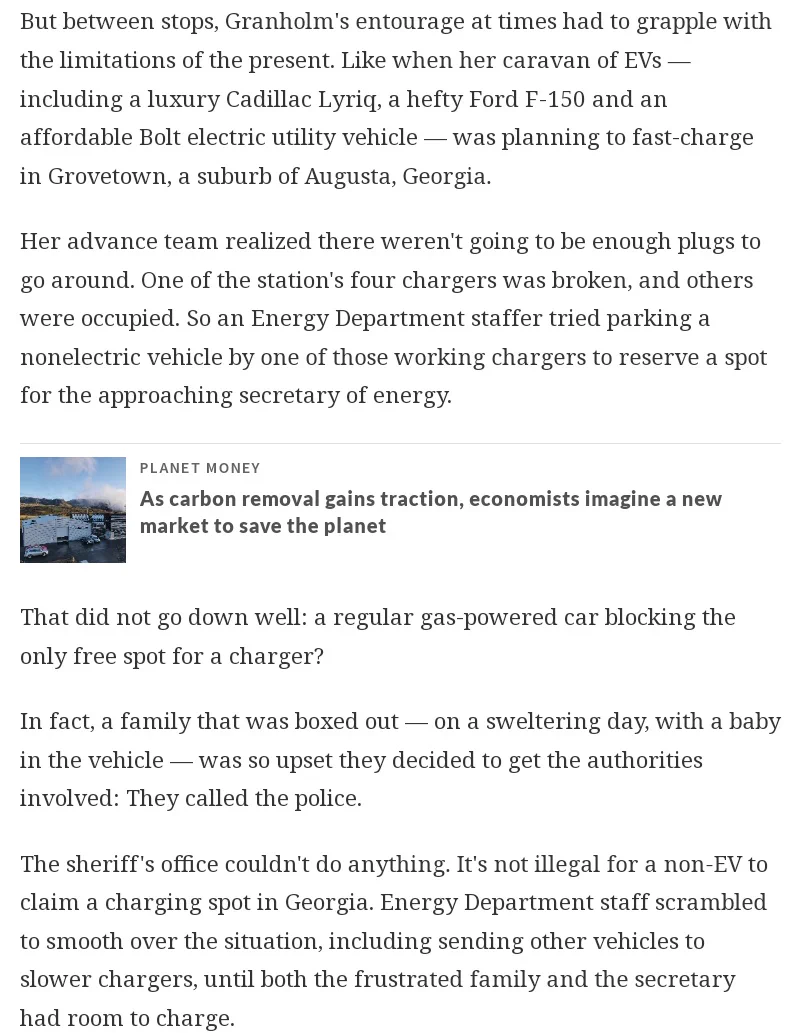Electric cars have a road trip problem, even for the secretary of energy
By Camila Domonoske – NPR – September 10, 2023
When Secretary of Energy Jennifer Granholm set out on a four-day electric-vehicle road trip this summer, she knew charging might be a challenge. But she probably didn’t expect anyone to call the cops.
Granholm’s trip through the southeast, from Charlotte, N.C., to Memphis, Tenn., was intended to draw attention to the billions of dollars the White House is pouring into green energy and clean cars. The administration’s ambitious energy agenda, if successful, could significantly cut U.S. emissions and reshape Americans’ lives in fundamental ways, including by putting many more people in electric vehicles.

Granholm approaches a charging station to charge the Cadillac Lyriq she was riding during a four-day road trip through the southeast early this summer. The electric vehicle had charging problems due to an “isolated hardware issue,” Cadillac says. But Granholm’s team encountered plenty of not-so-isolated problems too.
On town hall stops along her road trip, Granholm made a passionate, optimistic case for this transition. She often put up a photo of New York City in 1900, full of horses and carriages, with a single car. Then another slide: “Thirteen years later, same street. All these cars. Can you spot the horse?”
One horse was in the frame.
“Things are happening fast. You are in the center of it. Imagine how big clean energy industries will be in 13 years,” she told one audience in South Carolina. “How much stronger our economy is going to grow. How many good-paying jobs we’re going to create — and where we are going to lead the world.”
Going along for the ride
The auto industry, under immense pressure to tackle its contribution to climate change, is undertaking a remarkable switch to electric vehicles — but it’s not necessarily going to be a smooth transition.

Not every vehicle in Granholm’s caravan was electric. The Secret Service, for instance, rode in large traditional SUVs.
I rode along with Granholm during her trip, eager to see firsthand how the White House intends to promote a potentially transformative initiative to the public and what kind of issues it would encounter on the road.
Granholm is in many ways the perfect person to help pitch the United States’ ambitious shift to EVs. As a two-term former governor of Michigan, she helped rescue the auto industry during the 2008 global financial crisis, and she’s a longtime EV enthusiast. (Her family recently switched from the Chevy Bolt to the Ford Mustang Mach-E.)
That makes her uniquely well positioned to envision the future of the auto industry and to sell the dream of what that future could look like.
But between stops, Granholm’s entourage at times had to grapple with the limitations of the present. Like when her caravan of EVs — including a luxury Cadillac Lyriq, a hefty Ford F-150 and an affordable Bolt electric utility vehicle — was planning to fast-charge in Grovetown, a suburb of Augusta, Georgia.
Her advance team realized there weren’t going to be enough plugs to go around. One of the station’s four chargers was broken, and others were occupied. So an Energy Department staffer tried parking a nonelectric vehicle by one of those working chargers to reserve a spot for the approaching secretary of energy.
That did not go down well: a regular gas-powered car blocking the only free spot for a charger?
In fact, a family that was boxed out — on a sweltering day, with a baby in the vehicle — was so upset they decided to get the authorities involved: They called the police.
The sheriff’s office couldn’t do anything. It’s not illegal for a non-EV to claim a charging spot in Georgia. Energy Department staff scrambled to smooth over the situation, including sending other vehicles to slower chargers, until both the frustrated family and the secretary had room to charge.

This charging station in Grovetown, Ga., was overcrowded. An electric school bus that was driving on a statewide clean-energy road show needed one charger; another charger was broken.
Getting it together
John Ryan, a driver of an electric BMW, pulled up after everything was settled. It was his turn to wait.
“It’s just par for the course,” he shrugged. “They’ll get it together at some point.”
…
I asked her how she likes her SUV. And her answer summed up the anxieties and the hopes of both the Biden administration and the auto industry at large.
“It’s not enough chargers over on the major highways,” she said. And charging is “kind of slow.”
“Other than that, I wouldn’t take $100,000 for this car,” she said, smiling ear to ear. “We love it. We love the electric.”
#


NPR’s Camila Domonoske: The auto industry, under immense pressure to tackle its contribution to climate change, is undertaking a remarkable switch to electric vehicles — but it’s not necessarily going to be a smooth transition. … Granholm approaches a charging station to charge the Cadillac Lyriq she was riding during a four-day road trip through the southeast early this summer. The electric vehicle had charging problems due to an “isolated hardware issue,” Cadillac says. But Granholm’s team encountered plenty of not-so-isolated problems too. … Not every vehicle in Granholm’s caravan was electric. The Secret Service, for instance, rode in large traditional SUVs. …
Her advance team realized there weren’t going to be enough plugs to go around. One of the station’s four chargers was broken, and others were occupied. So an Energy Department staffer tried parking a nonelectric vehicle by one of those working chargers to reserve a spot for the approaching secretary of energy. That did not go down well: a regular gas-powered car blocking the only free spot for a charger?
In fact, a family that was boxed out — on a sweltering day, with a baby in the vehicle — was so upset they decided to get the authorities involved: They called the police.






